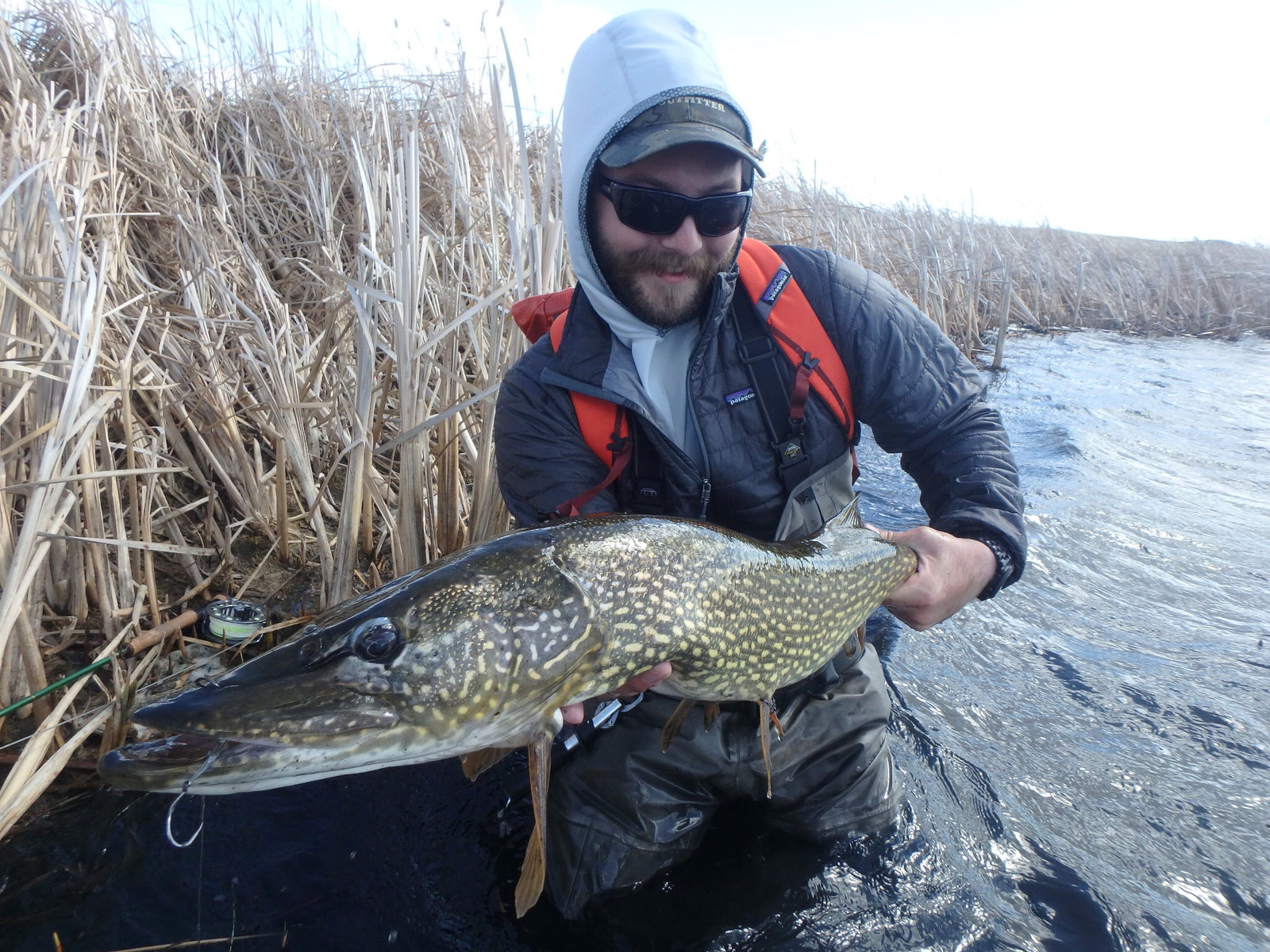Pike Techniques for Spring

Ryan Gabert |
Pike fishing has been starting to heat up around the Black Hills, and will continue to build steam over the next few weeks. Depending on what body of water you're fishing, the fish could be just getting ready to spawn, spawning, or could have been done for several weeks. These three different types of fish will all act dramatically differently. Because of that, there's a wide variety of techniques and line densities you'll need to be successful chasing pike around the area over the next few weeks.
Pre-spawn fish are going to be in the sub 50 degree water temperatures. Most of the lakes around the Black Hills and on the prairie are going to be warmer than this by now, but you could still run into some water that's that cold. A lot of these fish you see will be cruising just slightly below the surface, and oftentimes not moving too fast. It almost seems like they're sunning themselves, and they can often be tough to persuade to chase a fly or eat one. Since the fish are typically shallow, you'll want to have either a floating line or an intermediate line, like the RIO Outbound Short Floating or the Scientific Anglers Sonar Titan Full Intermediate. These fish can be laid up super shallow in the weeds, or will often be a few inches below the surface in deeper water. They can be really persnickety, but I've found if you can either make them move a long ways to the fly or put it right on their nose without spooking them they'll sometimes eat it. Typically you'll cast well beyond the fish, and then strip the fly in a way where the line never crosses the fish but you can get the fly to drop right on their nose when you get it in front of them. A fly that breathes in the water without you moving it is helpful, and they'll often nose down and slurp it off the bottom. For the fish that are out in more open water and not on the bottom, I usually try and cast well ahead of the fish - 8-12 feet - and move the fly quickly and try and get the fishes attention. If you can make the fish move a ways to catch up to the fly, I think you have an increased chance of them eating it. Pre-spawn fish can act funny. You'll throw in front of 15 of them and get almost zero reaction, and then you'll cast to one and it'll crush it on the first strip. Getting it in front of numbers of fish seems to be the key to success.
In our experience, spawning fish can be super aggressive, but if they're actively spawning you might as well move on and find some fish that are actually thinking about eating. If you see a big pike with several smaller ones swimming all around it and even running into each other, they're spawning and seem to have very little interest in what you have to cast at them. Pike spawn in dense vegetation, so when the water is in the high 40s to low 50s you'll find fish tucked into some of the densest weeds. Most of the time these fish are between 2-6 feet deep, so you'll need a bit heavier line if they're on the deeper end of that spectrum. The Sonar Intermediate is a good choice, and the RIO Outbound Type 3 is nice if they're a touch deeper. Keeping your fly at the pike's level seems to be pretty key - if your fly is constantly rising or sinking to the bottom they seem to lose interest pretty quickly, so the right density line is rather important. I try and make the fish move to the fly a few feet when the water temps are around 50. If you can get them interested enough to make them chase something you have a much higher chance of them eating it in our experience.
Post-Spawn fish are typically aggressive, and easier to persuade to eat. They'll stay shallow for a few weeks after they spawn, and then they'll move out into deeper water. This is where we've had some of our best luck for more numbers of fish. If the fish are in the shallow water, you can use the same lines as above to get your flies down to them. When they move out into the 6-12 foot range, we've had great luck with the multi-density Sonar Sinking lines from Scientific Anglers. The Hover/2/4 and Intermediate/3/5 are both great lines to fish down to about 10-12 feet. When the fish are this deep, you're going to mostly be fishing structure or drop offs rather than sight fishing them like you would when the water is cooler. Typically if you can find water that drops pretty quickly from 5 feet into 10-12 feet you'll find fish. Covering lots of water is important in this kind of fishing. Try and make a cast every 10-15 feet and you'll be showing your fly to the vast majority of fish. Since you can't see the fish, try and make your fly move erratically and dart side to side rather than just sliding through the water. Pike like some movement, and they really like flies that have side-to-side motion as well. Topographic lake maps can be found here, and are rather helpful in finding water that will be productive.
I'm a big believer in heavy fluorcarbon tippet in clear water, but wire can catch fish as well. I think that pressured fish get wary of a big shiny piece of wire hanging off the front of the fly, but your experiences may vary. I like Rio Fluoroflex in 80 pound, but if you want to use a wire leader the Scientific Anglers Apex Predator leaders are good as well.
Pike fishing is good throughout the Hills, and should continue to improve over the next few weeks. Swing by the shop for the latest scoop or flies, and give us a call if you'd like to go out on a pike guided trip with us!
